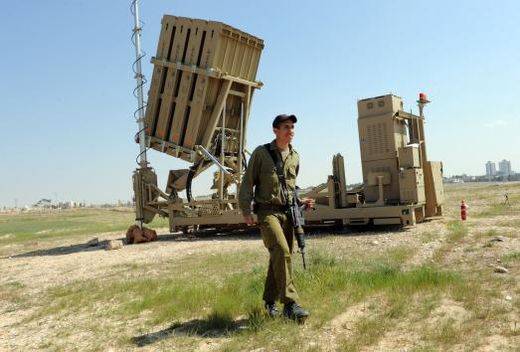
Israel's military air defence corps has four Iron Dome batteries deployed and will receive a fifth from state-owned Rafael Advanced Defense Systems Ltd after Barak rushed its production, his ministry said in a statement.
It said Barak would on Sunday, the beginning of the Israeli work week, ask the cabinet to earmark 750 million shekels ($190 million) for expanding the Iron Dome program. An Israeli official, speaking to Reuters on condition of anonymity, estimated that money would be enough for three more batteries.
First fielded last year, Iron Dome has served as a bulwark against rockets and mortar bombs fired by Palestinian militants in the Hamas-governed Gaza Strip.
The system has shot down 192 such missiles since fighting flared up on Wednesday, the Defence Ministry said.
Iron Dome, along with Israeli ballistic missile shield Arrow, has received extensive support from Washington, which seeks both to reassure and restrain the Jewish state in the face of the nuclear advances of its arch-enemy Iran.
The U.S. Congress approved $205 million for Iron Dome in fiscal year 2011, which ended on September 30. President Barack Obama's administration said on March 27 it would seek "an appropriate level of funding" for further acquisitions.
Barak's ministry said he wanted to draw from the $3 billion in annual U.S. defence grants to help pay for Iron Dome's expansion. Some $550 million has been spent over the past five years on Iron Dome development and manufacturing, it said.
BACK-BURNER TO BIG BOOST
Iron Dome was little more than a flimsy plan on a back shelf of the Defence Ministry when the 2006 summer war with Hezbollah erupted, bringing 4,000 rockets flying in from southern Lebanon.
The defence minister at the time, former trade union boss Amir Peretz, smarted at the sight of thousands of Israelis stewing in bomb shelters. As a resident of the southern town of Sderot, he was also aware that Palestinians in the nearby Gaza Strip were themselves amassing missiles.
So Peretz found the funds and ordered Rafael to rush Iron Dome into production. Rafael engineers worked around the clock, with the Haifa-based company keeping the pace competitive by having two rival teams put together different design proposals.
The winning version uses a variant of the missile detector on warplanes to spot ground-to-ground rocket and mortar launches. A quick calibration lets Iron Dome determine whether the missile is on course to hit a populated area, and ignore it if it is not. If Iron Dome decides to engage, it fires a guided missile that blows up the rocket or mortar shell in mid-air.
Iron Dome's first live trial was in July 2010. By April 2011, it was fielded outside Israel's southern city of Beersheba and shot down its first real Gazan rocket.
Iron Dome has been billed as providing city-sized coverage against Katyusha-style rockets with ranges of between 5 km (3 miles) and 70 km (42 miles), as well as mortar bombs. The system is truck-towed for easy transport, and Israel says it needs 13 of the batteries for satisfactory nationwide defence.
Rafael is in the last stages of developing a more powerful interceptor, David's Sling, that would use similar technologies against longer-range rockets and cruise missiles.
Each Iron Dome interception costs Israel between $30,000 and $50,000. Israeli officials say the system prevents potentially lethal rocket strikes that might force the country into a war that could cost as much as $380 million a day.
According to industry sources, Iron Dome's interception success rate is between 70 and 80 percent and should improve. Rafael has been working to expand Iron Dome's range to 250 km and make it more versatile so that it could intercept rockets coming from two directions simultaneously.



Al-Qassam Brigades "used SAM to hit Israeli aircraft" [Link]